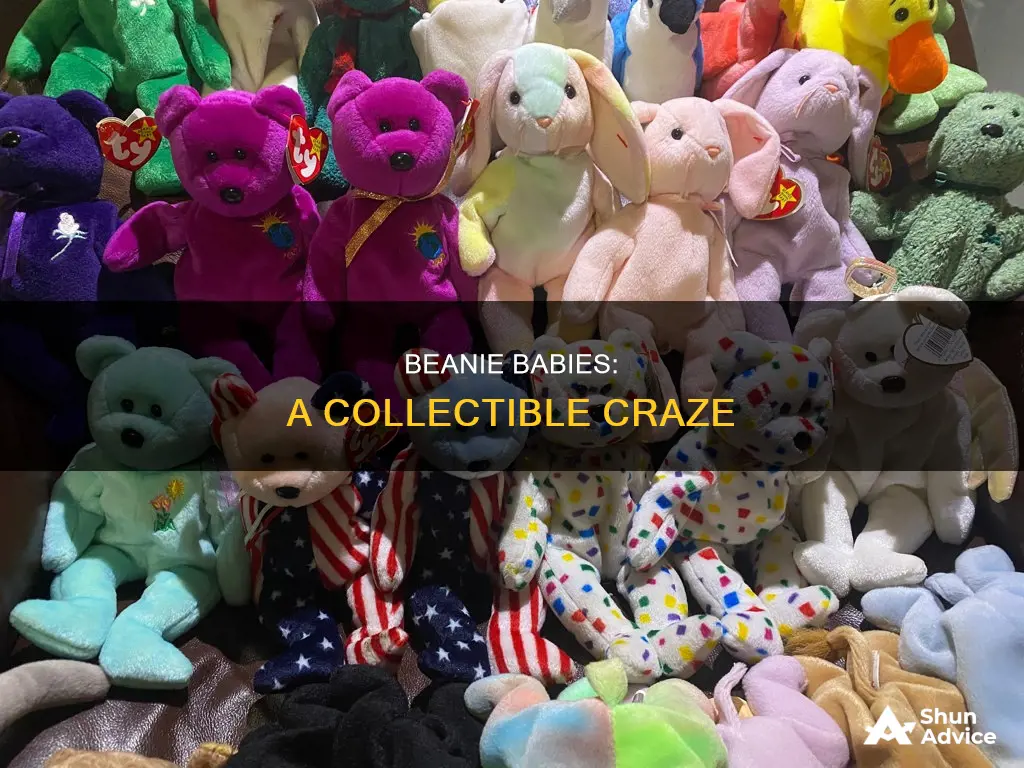
Beanie Babies were a line of stuffed toys created by American businessman Ty Warner and sold for around $5. They emerged as a major fad and collectible in the 1990s, with people investing in them as financial assets. Warner deliberately limited the supply of Beanie Babies, creating an artificial shortage that drove up demand and prices. This, along with clever marketing and the personification of the toys with names and poems, led to a speculative frenzy, with people believing that the toys would increase significantly in value over time. The bubble eventually burst, leaving many people with worthless collections, while Warner became a billionaire.
What You'll Learn

Ty Warner's business strategy
Warner also deliberately understuffed the toys, giving them a unique, flexible feel that made them stand out from other stuffed animals on the market. This "poseability" became a defining feature of Beanie Babies and enhanced their appeal.
Another key strategy was Warner's decision to frequently retire certain Beanie Babies, creating an artificial shortage and driving up demand. This tactic played on the fear of missing out and encouraged customers to buy in bulk. Warner also introduced new designs regularly, ensuring a constant stream of excitement and novelty.
Warner was a master at manipulating supply and demand. He sold Beanie Babies in small batches to independent businesses, refusing to supply large quantities to big-box retailers, and fixed the price of each toy at a relatively affordable $5. This pricing strategy made the toys accessible to children and easy for adults to purchase impulsively.
Warner also understood the power of personification and added tags with names and poems to the toys, making them more endearing to children. Additionally, he leveraged the early days of the internet to spread the word about Beanie Babies and created a company website where he made retirement announcements and speculated on possible retirements, driving collectors' behaviour.
Warner's business strategy was incredibly successful, and Beanie Babies became a cultural phenomenon, with sales of $1.4 billion in 1998 alone, turning Warner into a billionaire. However, the success was short-lived, and the Beanie Babies bubble eventually burst, leaving many investors with worthless collections.
Congress' Stock Secrets
You may want to see also

The psychology of collectors
Firstly, it's important to understand the concept of a "bubble". A bubble occurs when a product's value is rapidly inflated, often due to speculation and herd behaviour. The Beanie Babies bubble was a classic example of this, with people buying and selling the toys in the hope of making a profit. This created a self-perpetuating cycle, as the more people who bought into the craze, the more valuable the toys became.
Secondly, we need to consider the role of scarcity. Ty Warner, the creator of Beanie Babies, deliberately limited the supply of certain characters and retired them after a short period, creating an artificial scarcity. This scarcity drove up demand and made people believe that the toys were a valuable investment. This tactic played on the fear of missing out and the desire to acquire something that was perceived as rare.
Thirdly, the collectability of Beanie Babies cannot be understated. Each Beanie Baby had a unique birthday, poem, and name tag, which made them more personal and appealing to children and collectors. The idea that certain models were rare or discontinued fuelled the collecting frenzy, as people sought to complete their sets. This was further exacerbated by the secondary market, where collectors bought and sold Beanie Babies online and at auctions, often for highly inflated prices.
Finally, there was a strong element of nostalgia and emotional attachment associated with Beanie Babies. Many people who collected them as children or bought them for their children felt a sense of fondness and sentimentality towards the toys. This emotional connection may have clouded their judgment when it came to investing large sums of money in Beanie Babies.
While the Beanie Babies craze may seem like a harmless fad, it had serious financial consequences for many people. The crash of the Beanie Babies market left many investors with worthless collections and caused financial ruin for some. This serves as a reminder of the powerful psychological factors that can drive people's investment decisions.
Investment Calls: Why You?
You may want to see also

The Beanie Baby as a commodity
Beanie Babies were a line of stuffed toys created by American businessman Ty Warner, who founded Ty Inc. in 1986. The toys were stuffed with plastic pellets ("beans") instead of conventional soft stuffing. They came in many different forms, mostly animals. Created in 1993, Beanie Babies emerged as a major fad and collectible in the second half of the 1990s. They were cited as being the world's first Internet sensation in 1995. They were collected not only as toys but also as a financial investment, owing to the high resale value of particular ones.
The Beanie Babies' unique design set them apart from other stuffed animals on the market. Warner deliberately understuffed his toys so that they were flexible and "looked real". Each toy also came with two tags for identification: a heart-shaped "swing tag" at the top and a fabric "tush tag" at the bottom. These tags included the toy's name, a birthday, and a four-line poem related to the Beanie Baby. This personification made the toys more endearing to children.
Warner employed several strategies to create a sense of scarcity and drive demand for Beanie Babies. Firstly, he sold only small batches of each new Beanie Baby to independent businesses, refusing to supply large quantities to big-box retailers. Secondly, he sold them at a fixed price of $5 each. Thirdly, he would "'retire' certain characters after a short period, ceasing their production and introducing a new toy in its place. This strategy created a sense of urgency for consumers, who rushed out to buy the latest toy before supplies disappeared. Warner also restricted the quantity of Beanie Babies that could be produced and distributed, further limiting their availability.
The scarcity of Beanie Babies and the anticipation of future retirement created a huge secondary market for the toys and increased their popularity and value as collectibles. People began to speculate that all "retired" designs would rise in value, leading to a nationwide craze in the US. This speculation turned into a dangerous financial bubble as people invested large sums of money in Beanie Babies, expecting a significant return on their investment. However, the bubble eventually burst, leaving many people with worthless collections of stuffed animals.
While some sellers did see a substantial return on their investment, the vast majority did not. Today, surviving Beanie Babies are worth only a fraction of their original price, serving as a reminder of the fleeting nature of financial fads and the dangers of treating toys as commodities.
Wealthy Secrets: Where the Rich Invest
You may want to see also

The criminal enterprises that emerged
The Beanie Babies craze, which began in the 1990s, saw people neglecting other areas of their lives to spend all day trading, and some even invested their children's college funds in toys that they believed would bring an astronomical return on investment. The frenzy surrounding Beanie Babies led to the emergence of criminal enterprises and unethical practices.
One such enterprise was the theft and black-market sale of Beanie Babies. In 1998, a news article reported on the growing trend of Beanie Baby thefts, with some dolls being valued at over $1,000. Detective Timothy Goulden of Nashua, New Hampshire, investigated three separate Beanie Baby heists totalling more than $15,000. He believed that the trend was not limited to Nashua and was likely occurring across the United States. The article also mentions a couple from Nashua who were arrested for forging $2,400 in checks to buy Beanie Babies, and then selling the toys to fund their heroin addiction.
The secondary market for Beanie Babies also led to legal disputes and lawsuits. Ty Inc., the company behind Beanie Babies, was involved in numerous lawsuits related to trademark and copyright infringement. One such case was against Publications International, a company that published collector's books featuring Ty's Beanie Babies without authorisation. Ty sued for copyright and trademark infringement, arguing that Publications International violated its intellectual property rights by reproducing its protected works without permission.
The Beanie Baby craze also brought about unethical practices in the secondary market. Collectors and resellers engaged in price gouging, charging exorbitant prices for rare or retired Beanie Babies. Some people lost significant amounts of money investing in Beanie Babies, expecting them to increase in value over time. For example, Chris Robinson, a former actor, invested around $100,000 in Beanie Babies, hoping to pay for his children's college education. Unfortunately, he lost every penny, and was left with over 20,000 Beanie Babies.
The criminal enterprises and unethical practices that emerged during the Beanie Baby craze highlight the dark side of the collectible toy phenomenon. The high demand and perceived value of Beanie Babies led some people to engage in illegal and unethical behaviour to profit from the craze.
Fitness Investment: What's the Priority?
You may want to see also

The crash
The Beanie Babies bubble burst in 1999, when Ty Inc. announced that they would stop producing the toys by the end of the year. This announcement caused panic among sellers and a loss of interest from buyers, and by the year 2000, Beanie Babies had gone from an economic and cultural phenomenon to a tired punchline.
The first signs of the crash came in January 1999, when, after Ty Inc. announced a series of retirements, prices remained stable. This was the first time since the craze began that prices did not soar for a retired item. The company also announced the release of 24 new Beanie Babies that same day, overwhelming collectors and causing wholesale shipments to fall by 20% compared to the previous year.
By early 2000, newly retired Beanie Babies were selling three for $10, and by the end of the year, they were available in dollar stores nationwide. Sales declined by more than 90% in subsequent years, and in 2004, Ty Inc. reported losses of over $39 million.
Salary and Investment: A Correlation
You may want to see also
Frequently asked questions
People invested in Beanie Babies because they believed the value of the toys would increase over time. This belief was fuelled by collectors' manuals, which projected high future values for the toys.
Beanie Babies were deliberately designed to be collectible. Creator Ty Warner restricted the quantity of Beanie Babies produced and sold, creating an artificial scarcity that drove up demand. He also retired certain characters, further increasing their perceived value.
While some people made enormous returns on their investments, the vast majority did not. The Beanie Babies bubble eventually burst, leaving many people with collections worth only a fraction of what they had paid.







